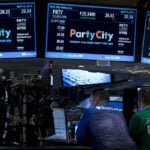By Davide Barbuscia and Shankar Ramakrishnan
NEW YORK (Reuters) - U.S. corporate credit spreads hit fresh multi-year lows in recent days in a sign of growing investor confidence, although some market participants worry corporate debt investors may be too optimistic given economic risks ahead.
The spread on the ICE BofA U.S. Corporate Index, a commonly used benchmark for high-grade debt, declined to 84 basis points this week, its lowest since 2005. Spreads were at 92 bps at the end of last month.
Spreads in the ICE BofA U.S. High Yield Index, which tracks so-called junk bonds, dipped to 289 basis points late last week, their lowest since March 2007. They were last at 299 bps as of Thursday, LSEG data on Friday showed.
Spreads indicate the premium investors demand to hold corporate bonds rather than safer government securities and are a gauge of market confidence.
Strong demand for bonds that are below investment grade, in particular, is seen as an optimistic signal, as investors see financial conditions as healthy and are less worried about corporate defaults.
"The probability of any type of meaningful recession is quite low, and so that's very supportive of the credit asset class," said Steven Oh, global head of credit and fixed income and co-head of leveraged finance at PineBridge Investments.
Still, he said there was a "level of complacency" in the market as prices did not account for the potential of a sharper economic slowdown than anticipated.
"Spreads are trading tight to where fair value is in a very supportive fundamental economic environment but one that is slowing," he said.
Treasury yields have surged this month as fears of an economic slowdown reversed after the Federal Reserve cut interest rates for the first time in over four years last month and data pointed to continued economic resilience.
Higher yields could incentivize investors to add more credit, a dynamic that has boosted demand for corporate debt in recent years.
Investment-grade bond issuance so far this year at $1.3 trillion is already 29% higher than the volumes in the year earlier period, according to Informa Global Markets data.
At the same time, as the Fed is expected to lower rates further, that reduces risks around debt refinancing, improving the outlook for companies strained by high borrowing costs, said Dominic Pappalardo, chief multi-asset strategist at investment research firm Morningstar.
"Investors may be more willing to move down in quality and allocate to credit sectors in place of government bonds to ensure they can still reach desired income bogeys," he said.
One hiccup could be the U.S. election on Nov . 5, which could rattle markets.
"There always exists the possibility of conditions becoming more difficult in November," said Richard Wolff, head of U.S. bond syndicate at Societe Generale CIB, who has been advising clients to move their funding plans forward, if possible.
Still, given yields of around 7% for high-yield bonds, some believe there's plenty of cushion to absorb a potential widening of spreads.
"Junk credit spreads still have room to tighten even though they are at their tightest levels in years," said Nick Burns, portfolio manager at Payden & Rygel.
"Assuming flat rates, you’d need to see spreads widen materially and/or defaults increase substantially before realizing a negative return over a given twelve month period with starting yields at that level,” said Burns.
(Reporting by Davide Barbuscia and Shankar Ramakrishnan; additional reporting by Matt Tracy; Editing by Diane Craft)

 How to save a fentanyl victim: Key facts about naloxone
How to save a fentanyl victim: Key facts about naloxone
 Eight convicted in France over murder of teacher who showed Prophet caricature
Eight convicted in France over murder of teacher who showed Prophet caricature
 Death toll from German Christmas market car-ramming rises to four, Bild reports
Death toll from German Christmas market car-ramming rises to four, Bild reports
 France's Mayotte struggles to recover as cyclone overwhelms hospitals
France's Mayotte struggles to recover as cyclone overwhelms hospitals
 Russia's UK embassy denounces G7 loans to Ukraine as 'fraudulent scheme'
Russia's UK embassy denounces G7 loans to Ukraine as 'fraudulent scheme'
 Pope calls Gaza airstrikes 'cruelty' after Israeli minister's criticism
Pope calls Gaza airstrikes 'cruelty' after Israeli minister's criticism
 Retailer Party City files for bankruptcy, will wind down 700 stores
Retailer Party City files for bankruptcy, will wind down 700 stores
 Soccer's top players have had enough, as FIFA's new super-sized tournament sparks a revolt
Soccer's top players have had enough, as FIFA's new super-sized tournament sparks a revolt
 Lindsey Vonn finishes 14th in a super-G to mark her return to World Cup skiing at age 40
Lindsey Vonn finishes 14th in a super-G to mark her return to World Cup skiing at age 40
 Santa and Mrs. Claus use military transports to bring Christmas to an Alaska Native village
Santa and Mrs. Claus use military transports to bring Christmas to an Alaska Native village








